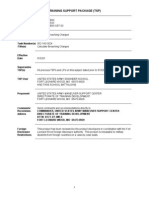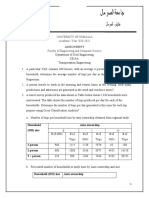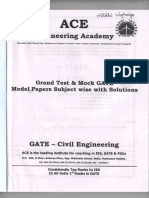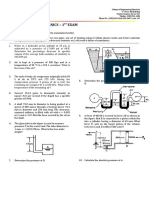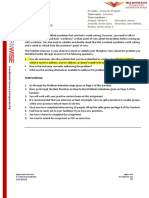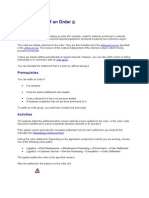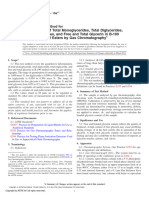Transpo
Transpo
Uploaded by
Jasper AgbuyaCopyright:
Available Formats
Transpo
Transpo
Uploaded by
Jasper AgbuyaOriginal Description:
Copyright
Available Formats
Share this document
Did you find this document useful?
Is this content inappropriate?
Copyright:
Available Formats
Transpo
Transpo
Uploaded by
Jasper AgbuyaCopyright:
Available Formats
1.
The Relationship between the space mean speed and (U) and the density (k) on a given transportation
facility can be described as u=100-0.85k, where u is in kph. Determine the free flow speed(uf), jam
density(kj) and the maximum flow(qmax) for this facility.
SOLUTION:
a.) Uf=100-0.85k ans. 100 kph
b.) Kj=100-0.85(k)=0 ans. 117.647 veh/km
c.) qmax= 100(117.647) / 4 ans.2941.175 veh/hr
2. Data obtained from an aerial photography shows 12 vehicles on a 275m long section of road. For the
same section, an observer counts a total of 7 vehicles during 15s interval. Determine a.) the spacing of
vehicles b.) time headway between successive vehicles c.) space mean speed
SOLUTION:
a). s=275/12 ans. 22.917 veh/m
b.) ht=15/7 =2.143 x 1/60 ans. 0.036 veh/min
c.) us= 28/0.044 ans. 641.667 or 636.364 m/s
3. The Section of the freeway is has a speed-flow relationship of the form q=au^2+bu. The section has a
maximum flow rate value or capacity equal to 2000 veh/hr
a.) 52= uf/2 ans. 104 km/hr
b.) 2000=(104)(kj)/4 ans. 76.923veh/km
c.) 900= (-0.073964497)(u)^2+(1000/13)u ans.u1=90.563km/hr u2=13.436km/hr
4. An observer has determined that the time headway between successive vehicles on a section of a
highway are exponentially distributed and that 65% of the headways between vehicles 9 seconds or
greater.
SOLUTION:
a.) P(4) = (0.048x30)^4 e^-(0.048)(30)/4! ans. 4.245%
5. A section of a highway is known to have a free flow speed of 95 mi/h and a capacity of 5300veh/h. In
a given hour, 2900 vehicles were counted at a specified point along this highway section.
SOLUTION:
b.) 2900=223.1584-u^2/95 (223.158) ans. U1=79.464 mi/hr U2=15.534 mi/hr
------------------------------------------------------------------------------------------------------------------------------------------
1. Vehicles begin to arrive at a park entrance at 7:45a.m at a constant rate of 6 vehicles per minute and
at a constant rate of 4 vehicles per minute from 8:00am onwards.
SOLUTION
a.) Determine the maximum departure rate needed to achieve the said condition?
P x 15 = 90 +15 x 4 ans. 10veh/minute
b.) Determine the total vehicle delay for said condition/
T= 675 +90t – 45t
=675 + 45t
675 +45t = 810 + 360t
t=15minutes
T=675+45(15) ans.1350minutes
2. At 8:00am there are 10 vehicles in a queue at a toll booth and vehicles area arriving at the rate of
A(t)=6.9-0.2t, beginning at 8:00am. Vehicles are being serviced at a rate of u(t)=2.1+0.3t.
SOLUTION
a.) What is the maximum queue length?
Q(t) = 4.8 x 9.6 - 0.25 x (9.6)^2 ans. 23.04veh
b.) what would the total vehicle delay be from 8:00am until the queue clears?
0.25t =4.8 t=19.2min
D1= 1,271.80-233.57-917.91 ans. 120.31 veh/min
3. At a parking lot, vehicles arrive according to a poisson process and are processed at a uniform
deterministic rate at a single station. The mean arrival is 4.2 veh/min and the processing rate is 5
veh/min.
a.) determine the average length of queue
Q=0.84^2 / 2(1-0.84) ans. 2.205
b.) Determine average time spent in the system.
W= 0.84 / 2(5) (1-0.84) ans. 0.525min/veh
c.) Determine the average waiting time in queue.
T=2-0.84 / 2(5)(1-0.84) ans. 0.725 min/veh
4. An impaired driver checkpoint, the time required to conduct the impairment test varies depending on
the compliance of the driver, but takes 60seconds on average.
SOLUTION
a.) Determine the average time spent in the system
t= 1/u-x = 1/1-(1/2) ans. 2min/veh
5. Vehicles arrive at a toll bridge at a rate of 420 veh/h. 2 toll booths are open and each can process
arrivals at a mean rate of 12 seconds per vehicle.
a.) Determine the average length of queue
Q= (3/n)(1.4)^4/2!2 (1/(1-1.4/2)^2) ans. 1.345
b.)Determine the average time spent in the system.
T= 1.4+ 1.345 / 7 ans. 0.392 min/ veh
------------------------------------------------------------------------------------------------------------------------------------------
1. An intersection has a three phase signal with the movements allowed in each phase and
corresponding analysis and saturation flow rate shown in the given TABLE.
a.) Calculate the minimum cycle length
b.) Calculate effective green time for each phase?
C.) Determine the optimum cycle length
Yc = 0.709
Tl=4(3) = 12s
Cmin = (12)(0.9) / 0.9-0.709 = 56.545=60sec
G11 = 0.209 (60/0.9) = 13.933= 15sec
G12 = 0.331 (60/0.9) = 22.067= 25sec
G13= 0.169 (60/0.9) =15sec
2. Minimum cycle length for intersection is determined to be 95 seconds. The critical lane 0.235, 0.250,
0.170 and 0.125
SOLUTION
a.) Determine the value of C used
95=(20)(Xc)/Xc-0.78) ans. 0.988
3. Consider the given intersection. Suppose northbound and southbound approaches are both on an 8%
upgrade
a.) Determine the yellow NB-SB
1+51.333/2(10)+2(32.2)(0/100) ans. 3.041=3.5s
b.) Determine the all read NB-SB
36+20/58.667 ans.0.95s
c.) Determine the yellow EB-WB
1+58.667/2(10)+2(32.2)(0/100) ans. 3.933= 4s
d.) Determine the all red EB-WB
60+20/51.333 ans. 1.364 = 1.5s
4. Compute the pedestrian green time for the NB-SB and EB-WB approaches of the intersection given in
the previous problem.
a.) Determine the pedestrian green NB-SB
3.2 + 36/3.5 + (0.27x20) ans. 18.8857sec
b.) Determine the pedestrian green EB-WB
3.2 + 60/ 3.5 + (0.27x20) ans. 25.743sec
5. An approach to a pretimed signal has 30 seconds of effective red and D/D/1 queuing holds. The total
delay approach is 83.33 veh-s/cycle
a.) Determine the flow rate
166 = v x 30^2 x 0.278 / 0.278- v v=0.110veh/s
V = 0.110 x 3600 ans. 396 veh/hr
b.) Cycle length
0.605C = 30 ans. 49.58=50sec
You might also like
- Porsche 911 Carrera (Type 996) Service Manual: 1999-2005 - Complete IndexDocument11 pagesPorsche 911 Carrera (Type 996) Service Manual: 1999-2005 - Complete IndexBentley Publishers33% (12)
- CDBM Mod03 AnswersDocument20 pagesCDBM Mod03 AnswersMoin Kabir MoinNo ratings yet
- Full Report - Production - of - MethanolDocument67 pagesFull Report - Production - of - Methanolhisham100% (4)
- A 03 DemoDocument21 pagesA 03 DemoLo Shun FatNo ratings yet
- xCE 3121L CMT LABORATORY - MIDTERM EXAMINATION PDFDocument3 pagesxCE 3121L CMT LABORATORY - MIDTERM EXAMINATION PDFJmee LaurestaNo ratings yet
- Tarea Runoff-Precipitation-FloodDocument3 pagesTarea Runoff-Precipitation-FloodChristian GarciaNo ratings yet
- IDF ProcedureDocument5 pagesIDF ProcedurechrisNo ratings yet
- Scale FactorsDocument12 pagesScale FactorsCatherine Shaina O. PasionNo ratings yet
- University of Somalia Academic Year 2020-2021: AssignmentDocument3 pagesUniversity of Somalia Academic Year 2020-2021: AssignmentFuaad Abdirizak ElmiNo ratings yet
- Slickline-Tools Catalog en WebDocument57 pagesSlickline-Tools Catalog en Webneoamn100% (1)
- Module 2 - Traffic FlowDocument17 pagesModule 2 - Traffic FlowEymxel BienvenidoNo ratings yet
- Fluids Exp 2Document9 pagesFluids Exp 2Ely ReyesNo ratings yet
- Question Bank For TrafficDocument4 pagesQuestion Bank For TrafficjananiNo ratings yet
- Problem SetDocument2 pagesProblem Setmichael davidNo ratings yet
- PE 13 Slope StabilityDocument12 pagesPE 13 Slope StabilityGreg KeldjianNo ratings yet
- 90Document1 page90Muhammad Junaid KhanNo ratings yet
- Prelim Reviewer - Ce LawDocument14 pagesPrelim Reviewer - Ce Lawm.hamsyyNo ratings yet
- 7-2 Infiltration ModelsDocument18 pages7-2 Infiltration ModelsStavan Lakhdharia100% (2)
- Probability Virtual Review (November 2020)Document3 pagesProbability Virtual Review (November 2020)jlNo ratings yet
- Gandhara Institute of Science & Technology, PeshawarDocument1 pageGandhara Institute of Science & Technology, PeshawarmarkhanNo ratings yet
- Strength of MaterialsDocument6 pagesStrength of MaterialsRafael Santos100% (1)
- Flow Through An Orifice: Experiment No. 05Document2 pagesFlow Through An Orifice: Experiment No. 05ChristopherHiladoNo ratings yet
- Soil HomeworkDocument29 pagesSoil HomeworkPoopriaw TanapornNo ratings yet
- Design of Vertical StirrupDocument3 pagesDesign of Vertical StirrupAnton_Young_1962No ratings yet
- Chapter-1: Introduction To Dynamics Mechanics As The Origin of DynamicsDocument92 pagesChapter-1: Introduction To Dynamics Mechanics As The Origin of DynamicsRoutine Of Nepal BandaNo ratings yet
- Assignment 1Document28 pagesAssignment 1Atul KumarNo ratings yet
- Bearing Plates: Allowable Bearing Stress of Concrete WallDocument3 pagesBearing Plates: Allowable Bearing Stress of Concrete WallNajib A. CasanNo ratings yet
- DynamicsDocument3 pagesDynamicsjj012586No ratings yet
- Algebra Answers FallerDocument7 pagesAlgebra Answers FallerJovelt PoncianoNo ratings yet
- Work Pressure and DE Worded For MEDocument3 pagesWork Pressure and DE Worded For MEAngelo Perez DalanginNo ratings yet
- MIT Math Correl 2nd Term AY 2014 2015 RetakeDocument9 pagesMIT Math Correl 2nd Term AY 2014 2015 RetakeJhera Ku100% (1)
- 602 CompDocument12 pages602 CompCyndrille John BragatNo ratings yet
- m4 TranspoDocument101 pagesm4 TranspomarcusluismacusiNo ratings yet
- Item 104Document28 pagesItem 104Wilbert Carlo RachoNo ratings yet
- Bearing Capacity: Gross Bearing Capacity (Q)Document12 pagesBearing Capacity: Gross Bearing Capacity (Q)Mozammil SarwarNo ratings yet
- Preboard DifcalDocument4 pagesPreboard DifcalBasti BauNo ratings yet
- Fluid Mechanicsunit 1Document31 pagesFluid Mechanicsunit 1srajubasavaNo ratings yet
- Instruction Manual HB 100 Hydraulics BenchDocument12 pagesInstruction Manual HB 100 Hydraulics BenchIndradhi LasmanaNo ratings yet
- Model Test PaperDocument222 pagesModel Test Paperpandya aksharNo ratings yet
- 7 Osborne Reynold'S Demonstration: Mapúa UniversityDocument11 pages7 Osborne Reynold'S Demonstration: Mapúa UniversityJemuel FloresNo ratings yet
- FA NO. 7 (Problem Set)Document2 pagesFA NO. 7 (Problem Set)Peter Adrian Ngo100% (1)
- Chapter 4 Traffic ParametersDocument6 pagesChapter 4 Traffic ParametersJohn Vincent PinedaNo ratings yet
- Ahs Final Coaching 2023 Nov.Document24 pagesAhs Final Coaching 2023 Nov.Gon MirNo ratings yet
- Quiz Bowl: AUGUST 13, 2019Document36 pagesQuiz Bowl: AUGUST 13, 2019Armenion Mark AllenNo ratings yet
- Chapter 2Document12 pagesChapter 2Wayaya2009No ratings yet
- Construction Materials and Testing: Laboratory ManualDocument84 pagesConstruction Materials and Testing: Laboratory ManualDaryll ArnestoNo ratings yet
- Chapter 3Document26 pagesChapter 3Khalifa AbdallaNo ratings yet
- Ce 343L - Fluid Mechanics - 1 ExamDocument2 pagesCe 343L - Fluid Mechanics - 1 ExamMichelle Daarol100% (1)
- War 2103 PrecipitationDocument52 pagesWar 2103 PrecipitationEgana IsaacNo ratings yet
- Factor UDocument1 pageFactor UseaedoNo ratings yet
- Pipes Dia. Length Friction "F" 1 900 MM 1500 M 0.0208 2 600 MM 450 M 0.0168 3 450 MM 1200 M 0.0175Document1 pagePipes Dia. Length Friction "F" 1 900 MM 1500 M 0.0208 2 600 MM 450 M 0.0168 3 450 MM 1200 M 0.0175John Mortel AparicioNo ratings yet
- Eval 5 - Xpertz Ce ReviewDocument27 pagesEval 5 - Xpertz Ce ReviewSteven ValerioNo ratings yet
- Quiz No. 4Document1 pageQuiz No. 4Cristina SarmientoNo ratings yet
- Fluid Mechanics Problem 1: Pressures Are Sometimes Determined by Measuring The Height of A Column ofDocument21 pagesFluid Mechanics Problem 1: Pressures Are Sometimes Determined by Measuring The Height of A Column ofEngineering NepalNo ratings yet
- Ce BoardDocument8 pagesCe BoardAllan Añavisa Ostique Jr.No ratings yet
- Problem Set 1 Properties of MaterialDocument9 pagesProblem Set 1 Properties of Materialale.123No ratings yet
- Direct Shear Box Test ManualDocument2 pagesDirect Shear Box Test ManualAwaraa ArpanNo ratings yet
- Cee 109 - First ExamDocument43 pagesCee 109 - First ExamRonald Renon QuiranteNo ratings yet
- Soil Mechanics Problem SetDocument7 pagesSoil Mechanics Problem SetChristine YasaNo ratings yet
- Numerical Methods and Implementation in Geotechnical Engineering – Part 1From EverandNumerical Methods and Implementation in Geotechnical Engineering – Part 1No ratings yet
- Transportation EngineeringDocument11 pagesTransportation EngineeringStphn FmlrNo ratings yet
- Reviews 1 - AnswerDocument13 pagesReviews 1 - AnswerQuỳnh NguyễnNo ratings yet
- Linkend 3Document1 pageLinkend 3Jasper AgbuyaNo ratings yet
- Civil Engineering Profession: History of Structural EngineeringDocument2 pagesCivil Engineering Profession: History of Structural EngineeringJasper AgbuyaNo ratings yet
- Education: Civil EngineerDocument2 pagesEducation: Civil EngineerJasper AgbuyaNo ratings yet
- Resume: Use Hubspot'S Linkedin Summary Templates To Write A Stand-Out Linkedin Bio For Your ProfileDocument2 pagesResume: Use Hubspot'S Linkedin Summary Templates To Write A Stand-Out Linkedin Bio For Your ProfileJasper AgbuyaNo ratings yet
- 400 KN 300 KN 10 KN/M 15 KN/MDocument3 pages400 KN 300 KN 10 KN/M 15 KN/MJasper AgbuyaNo ratings yet
- Activity 2.2.1 Run Problem InterviewsDocument9 pagesActivity 2.2.1 Run Problem InterviewsJasper AgbuyaNo ratings yet
- Chem 002: Technological Institute of The PhilippinesDocument5 pagesChem 002: Technological Institute of The PhilippinesJasper AgbuyaNo ratings yet
- Sample Summary LinkendinDocument1 pageSample Summary LinkendinJasper AgbuyaNo ratings yet
- Double Integration MethodDocument20 pagesDouble Integration MethodJasper Agbuya100% (1)
- Major Components of A Watershed Management: Land Management Water Management Biomass ManagementDocument9 pagesMajor Components of A Watershed Management: Land Management Water Management Biomass ManagementJasper AgbuyaNo ratings yet
- Major Watersheds and River Basins in The PhilippinesDocument18 pagesMajor Watersheds and River Basins in The PhilippinesJasper AgbuyaNo ratings yet
- Analytic Geometry 2014 20151Document1 pageAnalytic Geometry 2014 20151Jasper AgbuyaNo ratings yet
- Final Exam: Covid19 Excel: Technological Institute of The PhilippinesDocument5 pagesFinal Exam: Covid19 Excel: Technological Institute of The PhilippinesJasper AgbuyaNo ratings yet
- A320 Computer Reset-2Document13 pagesA320 Computer Reset-2Michael SantosNo ratings yet
- Music GCSE RevisionDocument40 pagesMusic GCSE RevisionBethDuke100% (3)
- Embryonic: Larval Development in CarpsDocument11 pagesEmbryonic: Larval Development in CarpsjoshigautaNo ratings yet
- Direct Rubber Shear Test PDFDocument9 pagesDirect Rubber Shear Test PDFMohammad ShehabNo ratings yet
- CH 17Document4 pagesCH 17HàMềm0% (1)
- Settlement of An Work OrderDocument7 pagesSettlement of An Work OrderShashank Mani TripathiNo ratings yet
- LA - W12 Diag, Split, A (λ) &g (λ)Document6 pagesLA - W12 Diag, Split, A (λ) &g (λ)chamberblueNo ratings yet
- PSV Reaction Force Calculation: For Any Gas, Vapor, or SteamDocument1 pagePSV Reaction Force Calculation: For Any Gas, Vapor, or Steam20jose12luisNo ratings yet
- General Information:: Formal Lab Report Format Mrs. Toombs Senior ChemistryDocument6 pagesGeneral Information:: Formal Lab Report Format Mrs. Toombs Senior Chemistryeviltea101No ratings yet
- CEHEXAMDocument8 pagesCEHEXAMMbang Abdoul KaderNo ratings yet
- DAQO CatalogueDocument24 pagesDAQO CatalogueZigor Larrabe UribeNo ratings yet
- Cisco TelePresence MX300 G2 Wall Mounting Installation SheetDocument8 pagesCisco TelePresence MX300 G2 Wall Mounting Installation SheetTst TkrNo ratings yet
- Evtcxl Clutch TransmissionDocument64 pagesEvtcxl Clutch TransmissionRommel SalazarNo ratings yet
- Astm d6584 Analisa Fame Dengan GCDocument9 pagesAstm d6584 Analisa Fame Dengan GCeka_setyowati0No ratings yet
- Mathematics P6Document5 pagesMathematics P6M.G Nshimiyimana DanielNo ratings yet
- M.ed Syllabus DistanceDocument16 pagesM.ed Syllabus Distancesakin janNo ratings yet
- Features GenconDocument6 pagesFeatures GenconCesar SoaresNo ratings yet
- 999GPS Tracking Platform Operation Manual-201306Document15 pages999GPS Tracking Platform Operation Manual-201306Nath0% (1)
- CEMENT Testing - MATEST - BrochureDocument50 pagesCEMENT Testing - MATEST - BrochureSagirul IslamNo ratings yet
- Mod3-EE404 Industrial Instrumentation & Automation-KTUStudents - inDocument15 pagesMod3-EE404 Industrial Instrumentation & Automation-KTUStudents - inmariaNo ratings yet
- Machine Learning KTU Module 1Document77 pagesMachine Learning KTU Module 1Zayn TawfikNo ratings yet
- TaydaelectronicsDocument3 pagesTaydaelectronicsshaniquabeallNo ratings yet
- Physicalscience q2 Mod14 TheconsequencesofthepostulatesofspecialrelativitytheoryDocument27 pagesPhysicalscience q2 Mod14 TheconsequencesofthepostulatesofspecialrelativitytheoryHanzel MabilanganNo ratings yet
- New Chinese & English BrochuresDocument8 pagesNew Chinese & English BrochuresFelipe Pisklevits LaubeNo ratings yet
- Unit 13 - Week 12: Assignment 12Document3 pagesUnit 13 - Week 12: Assignment 12Raushan KashyapNo ratings yet
- Meteorological Instruments and Their UsesDocument22 pagesMeteorological Instruments and Their UsesYuvan89% (37)
- A0050305420-4-Cylinder TDI Unit Injector Engine (2 0 LTR 4-Valve) Mechanics PDFDocument360 pagesA0050305420-4-Cylinder TDI Unit Injector Engine (2 0 LTR 4-Valve) Mechanics PDFNiki AndersonNo ratings yet



